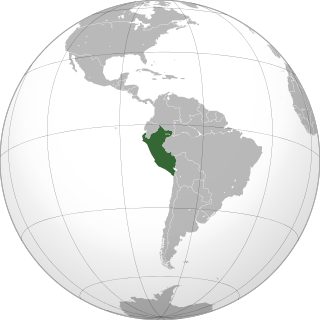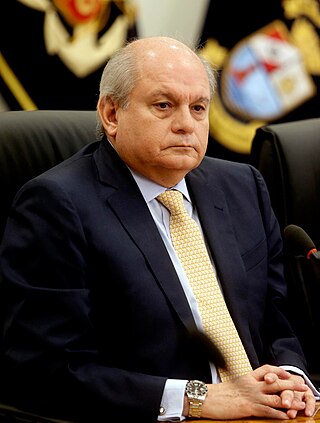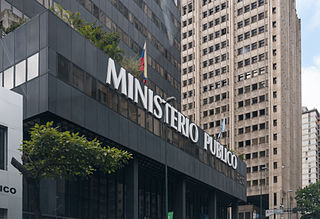
The President of Peru, officially called the Constitutional President of the Republic of Peru, is the head of state and head of government of Peru. The president is the head of the executive branch and is the Supreme Head of the Armed Forces and National Police of Peru. The office of president corresponds to the highest magistracy in the country, making the president the highest-ranking public official in Peru.

The Peru–Bolivian Confederation was a short-lived state that existed in South America between 1836 and 1839. The country was a loose confederation made up of three states: North Peru and South Peru—states that arose from the division of the Peruvian Republic due to the civil wars of 1834 and 1835 to 1836—as well as the Bolivian State.
The Republic of Peru is a unitary state with a multi-party semi-presidential system. The current government was established by the 1993 Constitution of Peru. The government is composed of three branches, being executive, judicial, and legislative branches.

Luis Miguel Sánchez Cerro was a high-ranking Peruvian army officer, revolutionary, nationalist and politician who served as the 41st President of Peru, from 1931 to 1933 as well as Interim President of Peru, officially as the President of the Provisional Government Junta, from 1930 to 1931. On August 22, 1930, as a lieutenant-colonel, he overturned the eleven-year dictatorship of Augusto B. Leguía after a coup d'état in Arequipa.
The Political Constitution of Peru is the supreme law of Peru. The current constitution, enacted on 31 December 1993, is Peru's fifth in the 20th century and replaced the 1979 Constitution. The Constitution was drafted by the Democratic Constituent Congress that was convened by President Alberto Fujimori during the Peruvian Constitutional Crisis of 1992 that followed his 1992 dissolution of Congress, was promulgated on 29 December 1993. A Democratic Constitutional Congress (CCD) was elected in 1992, and the final text was approved in a 1993 referendum. The Constitution was primarily created by Fujimori and supporters without the participation of any opposing entities.

The Supreme Court is the highest court in the Kingdom of Spain. The court has original jurisdiction over cases against high-ranking officials of the Kingdom and over cases regarding the legalization of political parties. It also has ultimate appellate jurisdiction over all cases. The Court has the power of judicial review, except for the judicial revision on constitutional matters, reserved to the Constitutional Court.

Jorge Alfredo Basadre Grohmann was a Peruvian historian known for his extensive publications about the independent history of his country. He served during two different administrations as Minister of Education and was also director of the Peruvian National Library.

Lesbian, gay, bisexual, and transgender (LGBT) people in Peru face some legal challenges not experienced by other residents. Same-sex sexual activity among consenting adults is legal. However, households headed by same-sex couples are not eligible for the same legal protections available to opposite-sex couples.

The National Police of Peru is the national police force of Peru. Its jurisdiction covers the nation's land, sea, and air territories. Formed from the merger of the Investigative Police, the Civil Guard, and the Republican Guard in 1988, it is one of the largest police forces in Latin America. Its mission is to preserve domestic order, public order and national security, in order to enforce the law and protect the people of Peru. The PNP is controlled by the Ministry of the Interior. The PNP has a number of divisions, tasked with enforcing specific aspects of the law; among the more well known are DIROES, DIRANDRO, DIRINCRI, and DIRCOTE (Anti-Terrorism).

Pedro Álvaro Cateriano Bellido is a Peruvian lawyer and politician who served as Prime Minister of Peru from July to August 2020, under Martín Vizcarra's administration. He previously served as Ollanta Humala's minister of defense from July 2012 to April 2015, and prime minister from April 2015 to July 2016.

The Public Ministry of Venezuela is an organ belonging to Citizen Power, it has autonomous and independent character. It is under the direction of the Attorney General of the Republic who is elected by the National Assembly for a period of seven years.
The National Board of Justice, formerly the National Council of the Magistrature, is an autonomous constitutional institution that is part of the Republic of Peru. Its primary function is to appoint and ratify all judges and prosecutors in the Peruvian justice system as well as to remove those that fail to fulfill their responsibilities.

José Salvador Cavero Ovalle was a Peruvian lawyer, judge, university lecturer, soldier and politician.

César Hinostroza is a Peruvian judge, lawyer, and fugitive who was a judge in the Peruvian Supreme Court from 2 January 2017 until his escape on July 11, 2018, in the midst of the political crisis in Peru. He is known for being involved in the CNM Audios scandal, a corruption scandal which led to his escape. When he escaped on 17 October, he was arrested following a warrant by Interpol, but was provisionally released on April 11, 2019.

The Cuellos Blancos scandal or the CNM Audios scandal is a judicial scandal caused by the revelation of audio recordings of judges and their staff, with the most notable individual being Associative Justice of the Supreme Court of Peru César Hinostroza, allegedly discussing bribes and reducing criminal penalties. These judges were part of the National Council of Magistracy. The scandal was revealed by an initiative led by the investigative journalism website IDL-Reporteros, which ultimately collected over 63,000 audio recordings that reportedly unveiled one of the largest corruption networks in Peru's judicial history. Following the scandal, the CNM would be restructured into the National Board of Justice (JNJ).

Liz Patricia Benavides Vargas is a Peruvian lawyer. On June 20, 2022, she was elected as Attorney General of Peru and was removed from her position on 7 December 2023 as a result of the Peruvian Public Ministry controversy.

Pedro Gálvez Egúsquiza was a Peruvian lawyer, politician, educator and diplomat. A staunch liberal, he was one of the leaders of the Liberal Revolution of 1854 headed by General Ramón Castilla. He is remembered for having been the drafter of the decree that abolished the tribute of the natives. He was Minister of Justice and Worship in 1855, and Minister of Finance and Commerce in 1862, in the second government of Ramón Castilla; President of the Council of Ministers and Minister of Government (1868–1869) in the government of José Balta; constituent deputy (1855–1857) and senator (1868–1869). Likewise, he exercised various diplomatic representations in the United States, Latin America and Europe.

Manuel María Gálvez Egúsquiza was a Peruvian lawyer, magistrate, university professor and politician.

An investigation surrounding the Public Ministry of Peru, known as Operation Valkyrie V resulted with a controversy surrounding the Attorney General of Peru, Patricia Benavides, who was alleged to head a criminal organization. The scandal revolved around alleged irregularities with the decisions of electing the Ombudsman of Peru Josué Gutiérrez Cóndor, dismissing former attorney general Zoraida Ávalos and attempts to remove the members of the National Board of Justice (JNJ), all in reported attempts for Benavides to main control of the Public Ministry by nominating allies in judicial positions.

The Ministry of Development and Public Works was a government ministry of Peru. Created in 1896, it oversaw the development of public works, infrastructure and charity. Its former headquarters, located at the Park of the Exhibition, now house the Metropolitan Museum of Lima since 2010.

















